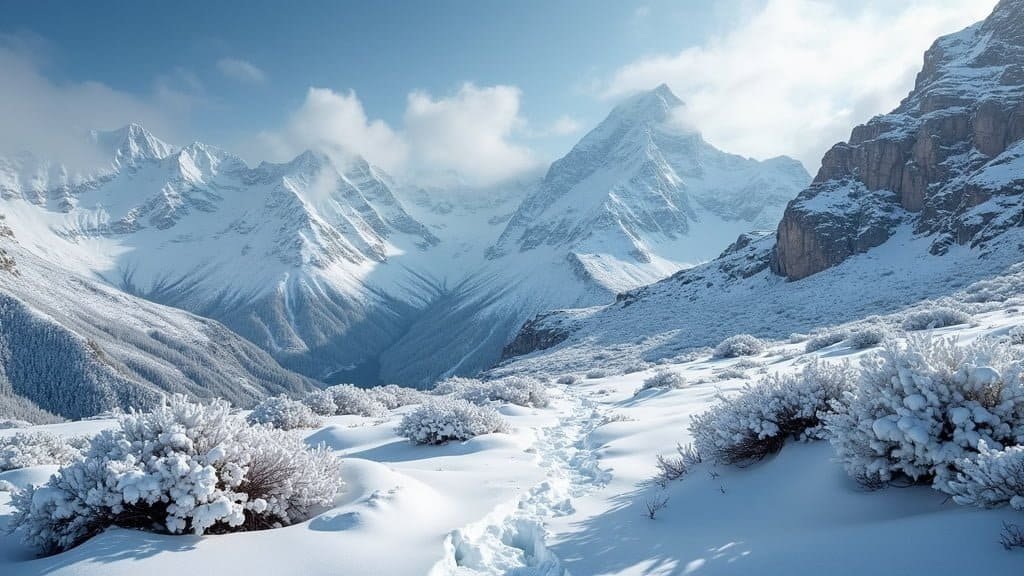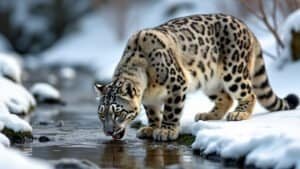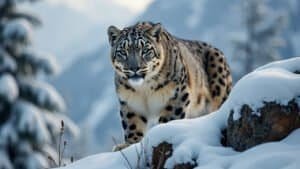Introduction
Snow leopards, elusive and majestic big cats, inhabit some of the world’s most rugged and remote regions. This article delves into the specific areas where these incredible animals can be found, spanning several countries and diverse habitats
We’ll explore the typical environments snow leopards thrive in, the protected areas established for their conservation, and their remarkable adaptations to survive in harsh conditions
Additionally, we’ll discuss the threats they face, the impact of climate change on their populations, and ongoing efforts to ensure their survival
Regions and Countries Home to Snow Leopards
Snow leopards are native to the high-altitude regions of Central and South Asia, where they have evolved to live in some of the harshest and most remote environments on Earth. These big cats are known for their elusive nature and are found across a range of countries, each offering unique landscapes that support their survival
Central Asia
Central Asia is a primary region where snow leopards can be found. This area includes countries such as Kazakhstan, Uzbekistan, Kyrgyzstan, and Tajikistan
In Kazakhstan, the Tien Shan mountains provide an ideal habitat, with snow leopards adapting to the cold, arid conditions. Similarly, the Pamir and Alay mountain ranges in Tajikistan and Kyrgyzstan offer rugged terrains that are perfect for snow leopards to thrive
In Uzbekistan, the presence of snow leopards in the Nuratau-Kyzylkum region has been documented, although sightings are rare due to the elusive nature of these animals
The Himalayas
The Himalayas are another critical region for snow leopards, extending across multiple countries including India, Nepal, Bhutan, and Tibet (China)
In India, snow leopards are primarily found in the states of Jammu and Kashmir, Himachal Pradesh, Uttarakhand, Sikkim, and Arunachal Pradesh. These areas are characterized by steep, rocky slopes and a sparse population, which provide a perfect setting for these solitary animals
Nepal’s Himalayan region, including the Annapurna and Langtang areas, is also home to a significant population of snow leopards
Bhutan’s high mountains and remote valleys provide another crucial habitat, while Tibet’s high plateau offers vast expanses where snow leopards can roam freely. The Himalayas’ varied terrain and climate conditions make it one of the most important regions for snow leopard conservation
Siberia and Russia
In Russia, snow leopards are primarily found in the southern Siberian mountains, particularly in the Altai and Sayan ranges. These areas provide the cold, mountainous environments that snow leopards are adapted to
The Altai mountains, stretching into Mongolia, are particularly significant as they represent the northernmost range of snow leopards. Efforts to monitor and protect snow leopards in these regions are ongoing, given the challenges posed by the remote and rugged terrain
Mongolia and China
Mongolia hosts a substantial population of snow leopards, particularly in the Altai mountains that border Russia and the Tien Shan range that extends into China. The country’s vast and diverse landscapes, ranging from deserts to high mountains, support a healthy population of snow leopards
China’s Xinjiang region, which includes the Tien Shan and Kunlun mountains, is another critical habitat. Additionally, the Qinghai-Tibet Plateau in China is a significant stronghold for snow leopards, with ongoing research and conservation efforts focused on protecting these areas
In these regions, snow leopards benefit from a combination of protected areas and traditional herding practices that coexist with wildlife. However, the pressures of habitat loss and human-wildlife conflict remain significant challenges that require continuous attention and action
Typical Habitat of Snow Leopards
Snow leopards are adapted to some of the harshest environments on Earth. They thrive in high-altitude regions characterized by rugged terrains and extreme weather conditions. Understanding their habitat preferences is crucial for effective conservation efforts
Mountainous Terrain
Snow leopards are predominantly found in mountainous regions, ranging from 9,800 to 17,000 feet above sea level. These altitudes provide the necessary solitude and space for these solitary animals
The steep, rocky slopes offer excellent vantage points for hunting and provide ample cover for stalking prey. The rugged terrain also helps snow leopards avoid human contact, reducing the risk of conflict
The mountainous regions where snow leopards live are often characterized by a mix of scree slopes, cliffs, and ravines. These features not only offer excellent camouflage but also serve as natural pathways for traversing their vast home ranges
In the Himalayas, for example, snow leopards are adept at navigating the rocky landscapes, often using narrow ledges and high cliffs to their advantage
Rocky Outcrops
Rocky outcrops are a significant feature of snow leopard habitats. These formations provide essential shelter and resting places, especially during the harsh winter months
Snow leopards use caves, crevices, and overhangs to protect themselves from the elements and to rear their cubs. The rugged rock structures also offer strategic points for ambushing prey, allowing snow leopards to utilize their exceptional agility and strength
In regions like the Tien Shan mountains in Central Asia, rocky outcrops are abundant and play a crucial role in the daily lives of snow leopards. These areas provide a natural fortification against predators and human disturbances, ensuring that snow leopards have a safe haven to retreat to when needed
Vegetation and Prey
While snow leopards are highly adapted to rocky, barren landscapes, the presence of vegetation is also crucial to their survival
Alpine meadows and scrublands interspersed with rocky areas provide an essential source of prey, such as blue sheep (bharal), ibex, and argali. The sparse vegetation in these high-altitude regions supports herbivores that are primary prey for snow leopards
In addition to large ungulates, snow leopards’ diet includes smaller mammals like marmots, hares, and birds
The availability of prey is a significant factor in determining the suitability of a habitat for snow leopards. Areas with abundant prey populations tend to support healthier and more stable snow leopard populations
The diversity of vegetation also contributes to the ecological balance of snow leopard habitats. Plants and shrubs not only provide food for herbivores but also help prevent soil erosion in these fragile environments. Conservation efforts often focus on maintaining this delicate balance to ensure that both prey and predators can thrive
Protected Areas and Conservation Efforts
Conservation efforts for snow leopards are critical for ensuring the survival of this endangered species. Many countries within the snow leopard’s range have established protected areas and launched various programs to safeguard these elusive big cats
National Parks and Reserves
Several national parks and reserves have been designated to protect snow leopard habitats. In India, the Hemis National Park in Ladakh is renowned for its efforts to conserve snow leopards. This park, spanning over 1,700 square miles, provides a safe haven for these animals and supports extensive research and monitoring activities
In Nepal, the Annapurna Conservation Area is a vital refuge for snow leopards
Spanning over 2,946 square miles, this area integrates community-based conservation with habitat protection, ensuring local communities benefit from and contribute to wildlife conservation. Similarly, Bhutan’s Jigme Dorji National Park is another critical area that supports a healthy population of snow leopards
Mongolia’s Gobi Gurvansaikhan National Park is notable for its diverse landscapes, including desert and mountain habitats, providing an ideal environment for snow leopards. These protected areas are crucial for maintaining the ecological balance and providing secure habitats for snow leopards and their prey
International Conservation Programs
Several international organizations are actively involved in snow leopard conservation
The Snow Leopard Trust, founded in 1981, focuses on research, community-based conservation, and education across snow leopard range countries. Their initiatives include livestock insurance programs, handicraft projects for local communities, and extensive ecological studies to better understand snow leopard behavior and habitats
The Snow Leopard Network, another key player, brings together researchers, conservationists, and policymakers from around the world. Their collaborative efforts aim to enhance knowledge sharing and implement effective conservation strategies
The Global Snow Leopard & Ecosystem Protection Program (GSLEP) is a significant initiative that involves 12 range countries. Launched in 2013, GSLEP aims to secure 20 snow leopard landscapes by 2020, focusing on habitat protection, community involvement, and transboundary cooperation
Community-Based Conservation
Community-based conservation programs play a vital role in snow leopard protection. Engaging local communities in conservation efforts helps mitigate human-wildlife conflicts and promotes sustainable livelihoods
In Kyrgyzstan, for example, the Snow Leopard Enterprises project collaborates with herders to produce and sell handicrafts, providing economic incentives for conservation
In India, the Snow Leopard Conservancy India Trust works closely with local communities to implement predator-proof livestock pens, reducing losses to snow leopards and fostering coexistence
Similar initiatives in Nepal involve the Snow Leopard Conservation Committee, which engages locals in monitoring and protecting snow leopard populations while promoting ecotourism as an alternative income source
These community-based approaches are essential for long-term conservation success. By involving local populations and addressing their needs, conservation programs can create sustainable and mutually beneficial solutions
Adaptations to the Environment
Snow leopards have evolved a range of unique adaptations that enable them to survive in some of the harshest environments on Earth. These adaptations are essential for their hunting strategies, physical endurance, and overall survival in the mountainous regions they inhabit
Physical Adaptations
One of the most striking adaptations of snow leopards is their thick fur, which provides insulation against the cold temperatures of their high-altitude habitats
Their fur is also patterned with rosettes and spots that help them blend into the rocky and snowy landscapes, providing camouflage from prey and potential threats. Snow leopards have long, dense tails that they use for balance while navigating steep, rocky terrain and also wrap around their bodies to keep warm when resting
Their bodies are compact and muscular, with strong, short limbs that give them the power and agility needed for jumping and climbing
Snow leopards are capable of leaping up to 50 feet in a single bound, a crucial skill for catching prey in their rugged environments. Their wide, fur-covered paws act like natural snowshoes, distributing their weight evenly and allowing them to walk on snow without sinking
Behavioral Adaptations
Snow leopards are solitary and elusive, behaviors that help them avoid detection by both prey and humans
They are primarily crepuscular, being most active at dawn and dusk when their prey is also active. This behavior reduces the likelihood of encountering humans and minimizes competition with other predators
Their hunting strategy involves stalking and ambushing prey, relying on their camouflage and stealth to get as close as possible before making a sudden, powerful leap. Snow leopards have large nasal cavities that warm the cold air they breathe, and their well-developed lungs and chest muscles are adapted to the thin, oxygen-poor air of high altitudes
Snow leopards also have a unique way of communicating through vocalizations, scent markings, and scratch marks. They use a range of sounds, including growls, hisses, and moans, but do not roar like other big cats. Instead, they produce a call known as a “chuff” or “prusten” to communicate with other snow leopards over long distances
Hunting Strategies
The prey base for snow leopards includes blue sheep, ibex, and Himalayan tahr, which are well-adapted to their mountainous environments
Snow leopards use their powerful hind legs to launch themselves at prey, often ambushing from above to catch their target by surprise. Their stealth and ability to move silently across rocky terrain are key components of their hunting success
Snow leopards have a unique way of consuming their prey. They often drag their kill to a secluded location before feeding, which helps to avoid scavengers and reduces the risk of attracting other predators
They can consume up to 20 pounds of meat in one sitting but may return to a kill several times over a period of days
Threats to Snow Leopard Populations
Snow leopards face numerous threats that jeopardize their survival. Understanding these threats is crucial for developing effective conservation strategies to protect these majestic big cats
Poaching and Illegal Trade
Poaching is a significant threat to snow leopards. Their fur is highly valued in the illegal wildlife trade, and their bones and other body parts are used in traditional medicine, particularly in Asia. Despite international and national laws protecting snow leopards, poaching continues due to high demand and lucrative profits
The Snow Leopard Trust reports that an estimated 220 to 450 snow leopards are killed annually, primarily for their pelts
The organization works with local communities to reduce poaching by providing alternative livelihoods and promoting the value of live snow leopards for eco-tourism and ecosystem health
Habitat Loss
Habitat loss due to human encroachment, infrastructure development, and resource extraction is another critical threat
As human populations expand into snow leopard territories, the animals’ natural habitats are fragmented and degraded. This leads to reduced prey availability and increased encounters with humans, often resulting in conflict
Mining, road construction, and agricultural expansion are major drivers of habitat loss in snow leopard regions. Conservation organizations advocate for sustainable development practices and the establishment of protected areas to mitigate these impacts
For instance, the World Wildlife Fund (WWF) collaborates with governments and local communities to promote land-use planning that considers wildlife corridors and protected zones
Human-Wildlife Conflict
Human-wildlife conflict is a significant issue in snow leopard conservation. Snow leopards sometimes prey on livestock, leading to retaliatory killings by herders. This conflict arises when natural prey is scarce or when livestock graze in snow leopard habitats
Programs such as predator-proof livestock pens and livestock insurance schemes have been implemented to address this issue
In Mongolia, the Snow Leopard Enterprises initiative provides herders with alternative income through the production and sale of handicrafts, reducing their reliance on livestock and mitigating conflict
Climate Change
Climate change poses an emerging threat to snow leopards by altering their high-altitude habitats
Rising temperatures can lead to changes in vegetation and prey distribution, forcing snow leopards to adapt to new conditions or move to higher altitudes. This can result in habitat fragmentation and increased competition for resources
A study published in Biological Conservation in 2020 indicates that climate change could reduce suitable snow leopard habitat by 30% by 2070. Conservation efforts must incorporate climate resilience, focusing on habitat connectivity and the preservation of critical areas that provide refuges for snow leopards
Prey Depletion
The depletion of prey species due to hunting and competition with livestock also threatens snow leopard populations. Key prey animals, such as blue sheep, ibex, and Himalayan tahr, are hunted by humans for food and traditional practices
Additionally, overgrazing by domestic livestock reduces the availability of natural forage for wild herbivores, leading to a decline in prey populations
Conservation programs aim to address this by implementing anti-poaching measures and promoting sustainable grazing practices. In Nepal, community-based wildlife monitoring programs involve local residents in protecting both prey and predator species, fostering a sense of stewardship and ensuring sustainable use of natural resources
Impact of Climate Change
Climate change is an emerging and significant threat to snow leopards, impacting their habitat, prey availability, and overall ecosystem dynamics. Understanding these impacts is critical for developing adaptive conservation strategies
Changing Habitats
Climate change affects snow leopard habitats by altering temperature and precipitation patterns
These changes can lead to shifts in vegetation zones, forcing snow leopards and their prey to move to higher altitudes. As these animals are pushed to the edges of their range, they may encounter more competition for limited resources
A study by the International Union for Conservation of Nature (IUCN) suggests that up to 30% of snow leopard habitat could be lost due to climate change by 2070. This loss of habitat reduces the areas available for snow leopards to live and hunt, increasing the risk of human-wildlife conflict as these animals are forced into closer proximity to human settlements
Effects on Prey Species
The impact of climate change on prey species is another critical concern. Snow leopards rely on a variety of ungulates, such as blue sheep, ibex, and Himalayan tahr, which are also affected by changing climate conditions
Alterations in vegetation can lead to changes in the distribution and abundance of these prey species, impacting the availability of food for snow leopards
A decline in prey populations can force snow leopards to expand their range in search of food, increasing the likelihood of encounters with humans and livestock. This can exacerbate human-wildlife conflicts and lead to retaliatory killings of snow leopards
Conservation Challenges
Climate change poses several challenges for snow leopard conservation. Traditional conservation strategies, such as the establishment of protected areas, may need to be adjusted to account for shifting habitats and the need for habitat connectivity. Ensuring that protected areas remain suitable for snow leopards and their prey is essential for long-term conservation success
One approach is to focus on creating climate-resilient landscapes by maintaining habitat corridors that allow snow leopards and their prey to move between areas. This can help mitigate the effects of habitat fragmentation and ensure that animals can access the resources they need to survive
Additionally, conservation programs must consider the socioeconomic impacts of climate change on local communities. Engaging these communities in adaptive management practices and providing support for sustainable livelihoods can help reduce pressure on snow leopard habitats and foster coexistence
Research and Monitoring
Ongoing research and monitoring are vital for understanding the impacts of climate change on snow leopards and developing effective conservation strategies. Remote sensing technology, such as satellite imagery and camera traps, can provide valuable data on habitat changes and snow leopard movements
Studies on the ecological responses of snow leopards and their prey to climate change can inform adaptive management practices
Collaborative efforts between scientists, conservation organizations, and local communities are essential for gathering data and implementing effective conservation measures
The Snow Leopard Trust, for example, conducts extensive research on snow leopard ecology and behavior, using this information to guide conservation actions. Their work highlights the importance of incorporating climate change considerations into conservation planning and ensuring that strategies are flexible and adaptive
Conclusion
Snow leopards inhabit some of the most remote and rugged regions of the world, primarily in Central and South Asia
These majestic big cats are found in countries like Kazakhstan, India, Nepal, Mongolia, and China, thriving in high-altitude habitats characterized by mountainous terrain and rocky outcrops. Conservation efforts are crucial for their survival, with numerous national parks, reserves, and international programs dedicated to protecting snow leopard populations and their habitats
Snow leopards have evolved unique physical and behavioral adaptations that enable them to survive in harsh environments. Their thick fur, powerful limbs, and solitary nature are just a few examples of how they are perfectly suited to their cold, mountainous homes
However, they face significant threats from poaching, habitat loss, human-wildlife conflict, and climate change. These challenges necessitate a multifaceted approach to conservation, including protected areas, community-based programs, and research
Climate change poses an additional, emerging threat by altering habitats and affecting prey species. Conservationists must consider climate resilience in their strategies, ensuring habitat connectivity and sustainable practices that benefit both snow leopards and local communities. Ongoing research and adaptive management are essential for mitigating these impacts and ensuring the long-term survival of snow leopards in the wild
By understanding the regions snow leopards inhabit, their adaptations, and the threats they face, we can better appreciate the importance of conserving these incredible animals
International cooperation and comprehensive conservation strategies are vital for protecting snow leopards and their unique ecosystems for future generations












